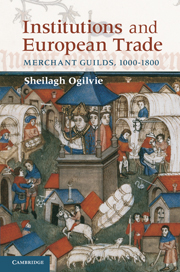Book contents
- Frontmatter
- Contents
- Acknowledgements
- 1 Merchant guilds, efficiency and social capital
- 2 What was a merchant guild?
- 3 Local merchant guilds
- 4 Alien merchant guilds and companies
- 5 Merchant guilds and rulers
- 6 Commercial security
- 7 Contract enforcement
- 8 Principal-agent problems
- 9 Information
- 10 Price volatility
- 11 Institutions, social capital and economic development
- Bibliography
- Index
1 - Merchant guilds, efficiency and social capital
Published online by Cambridge University Press: 05 June 2012
- Frontmatter
- Contents
- Acknowledgements
- 1 Merchant guilds, efficiency and social capital
- 2 What was a merchant guild?
- 3 Local merchant guilds
- 4 Alien merchant guilds and companies
- 5 Merchant guilds and rulers
- 6 Commercial security
- 7 Contract enforcement
- 8 Principal-agent problems
- 9 Information
- 10 Price volatility
- 11 Institutions, social capital and economic development
- Bibliography
- Index
Summary
Merchant guilds – privileged, corporate associations of wholesale traders – were important institutions in the European economy from the eleventh to the nineteenth century, and scholars are still arguing about them now. Historians debate their economic, social and political roles. Economists draw lessons from merchant guilds to support their theories about the institutions that support economic development. Social scientists view merchant guilds as prime historical examples of ‘social capital’, with important lessons for the present day.
But why did merchant guilds exist? Does their wide prevalence and long survival mean they were efficient institutions that benefited the entire economy? Or did they simply offer an effective way for rich and powerful men to grab a bigger slice of the pie, at the expense of outsiders, customers and society as a whole? These questions are controversial. This book shows that the answers to them can help us understand how economies grow, why institutions exist and what are the real effects of social capital.
Privileged associations of merchants have been widespread since ancient times. They existed not just in Europe but also in North Africa, the Near East, Central and South America, India and China. Merchant associations were active in Egyptian, Greek and Roman antiquity, and survived in European and Mediterranean trading centres during the five centuries after the fall of Rome.
- Type
- Chapter
- Information
- Institutions and European TradeMerchant Guilds, 1000–1800, pp. 1 - 18Publisher: Cambridge University PressPrint publication year: 2011
- 1
- Cited by

